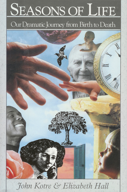

Seasons of Life
Our Dramatic Journey from Birth to Death
University of Michigan Paperback, 1997
Little, Brown Hardcover, 1990
Preview through Google Books
Buy through Amazon.com
This book is the companion volume to the PBS series that first aired in 1990. Like the series, it follows three "clocks" (biological, social, and psychological) as it explores the course of human development from the first day of life to the last. Individuals from each season of life tell their stories, and the authors (Elizabeth Hall and myself) present related research on growth and change throughout the life cycle.
"The reader is certain to be enriched... Seasons of Life is filled with valuable information."
-- Alvin F. Poussaint, M.D., Harvard Medical School
"The portrait of human life depicted here is a powerful one that transcends its sources and offers a new view of the ways in which Western man's evolution sometimes hinders and occasionally enhances his environmental reality. A thoughtful, thought-provoking work, and a credit to the series."
-- Kirkus Reviews
Prologue: A Time for Stories
I. Infancy
One: The Biological Clock
Two: The Social Clock
Three: The Psychological Clock
II. Childhood
Four: No Longer "In-fans"
Five: The First Day
Six: "How To" Time
III. Adolescence
Seven: Changing Bodies
Eight: A Ten-Year Lag
Nine: The Story Is the Self
IV. Early Adulthood
Ten: The Season of Fertility
Eleven: Two Families
Twelve: From Dream to Reality
V. Middle Adulthood
Thirteen: The Midpoint
Fourteen: The Baby Boom Is Forty
Fifteen: Time Lived, Time Left
VI. Late Adulthood
Sixteen: Twenty-five Extra Years
Seventeen: Pioneers of Aging
Eighteen: How the Story Ends
From Chapter 18
The Soul of a Tree
At eighty-two, George Nakashima of Bucks County, Pennsylvania, has carved his integrity out of the tradition of wood. His work is known internationally--furniture with butterfly joints and undulating edges that preserve the character of the original timber, furniture with holes and cracks turned to artistic advantage, furniture in which the soul of the wood comes through. . . .
"Until a few years ago, I completely disregarded getting old. But I'm afraid that there are certain things happening in my body that I can't deny anymore. I'm certainly curtailed physically. It was only four, maybe five years ago that I climbed a mountain in Japan, but I don't think I could climb it anymore. We were looking for the great cedar. Did I ever tell you?
"There's a great cedar in Japan, which they say is around seven thousand years of age. I think it's considerably older than the bristlecone pine, which for quite a while was considered the oldest inhabitant on earth. I've always been interested in this cedar, for ever since I was in Japan, I've heard about it. But only recently did I have the chance to go there.
"We arranged this safari -- friends of mine and myself. The lower part one could do in an automobile. And then we went on a little logging cart to the base of the mountain. From there it was all on foot -- pretty much a half-day climb. And I was determined to see this tree. Every once in a while the younger fellows asked me if I wanted to continue. And I'd say, 'Yes, we go on!' Parts of the mountain were almost vertical. We couldn't even climb up the rocks -- we had to go on ladders. But we finally made it. And it was a great sight, to see a spectacle like that. And actually going up to it and touching it was something else again."
Back in Bucks County, Pennsylvania, a huge oak stands near George's home. It's not nearly as old as the great cedar in Japan, but it's equally majestic. George has touched it often. "I feel that trees have a soul. In my work, I have to find the living spirit in a tree, explore it, and develop it. With a tree, you can read its whole history -- if you have the eyes to see. You can tell when there was a great drought. You can tell where there was an injury that was healed over. You can tell when there's great happiness in a tree -- a joy that expresses itself in its grains and its bark and its fibers. Trees have their problems, too. They have their bad moments. They have joy and they have sorrow, just like human beings. Some trees have character and others end up in something that's almost futile.
"The great oak down below, I think, is a tree that has tremendous character. How it's going to end up is a little hard to say. It will die, eventually. And one of our jobs is to take these great living things that have died or will die and give them, well, a second life. If I can bring the nature and the spirit of a tree back, the tree lives again. It's the continuity of life that sparks from one thing to another. It's a great, great feeling to be a part of that -- to be a part of nature and to be a part of life itself."